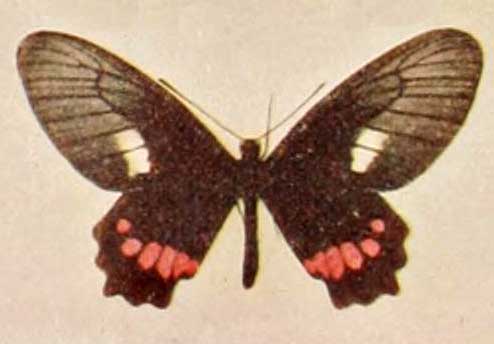
Parides agavus
Superregnum: Eukaryota
Cladus: Unikonta
Cladus: Opisthokonta
Cladus: Holozoa
Regnum: Animalia
Subregnum: Eumetazoa
Cladus: Bilateria
Cladus: Nephrozoa
Cladus: Protostomia
Cladus: Ecdysozoa
Cladus: Panarthropoda
Phylum: Arthropoda
Subphylum: Hexapoda
Classis: Insecta
Cladus: Dicondylia
Subclassis: Pterygota
Cladus: Metapterygota
Infraclassis: Neoptera
Cladus: Eumetabola
Cladus: Endopterygota
Superordo: Panorpida
Cladus: Amphiesmenoptera
Ordo: Lepidoptera
Subordo: Glossata
Cladus: Coelolepida
Cladus: Myoglossata
Cladus: Neolepidoptera
Infraordo: Heteroneura
Cladus: Eulepidoptera
Cladus: Ditrysia
Cladus: Apoditrysia
Cladus: Obtectomera
Superfamilia: Papilionoidea
Familia: Papilionidae
Subfamilia: Papilioninae
Tribus: Troidini
Subtribus: Troidina
Genus: Parides
Species: Parides klagesi
Name
Parides klagesi (Ehrmann, 1904)
Parides klagesi is a species of butterfly in the family Papilionidae. It was thought to be endemic to Venezuela before being discovered in Brazil. A recent, freely available article by Olaf Mielke and Mirna Casagrande (2007) summarizes the known geographical distribution of the species. Because of the prior CITES listing and apparent rarity, this species was placed in the endangered species list for the northern Brazilian state of Pará.
Description
A peculiar little species in which the hinder angle of the cell on the forewing is quite rounded; neither the forewing nor the hindwing has distinct fringe-spots. Forewing with a white band before the hindmargin; hindwing with a band composed of red spots. Abdomen entirely black, even at the tip.[3] The male, taken only in 1983, is described by Racheli and Pischedda (1987) [4][5] A full description of the female is provided by Rothschild, W. and Jordan, K. (1906)[6] BOA images
Habitat
Deciduous monsoon forest habitat. Sierra de Imataca, Venezuela
Seasonal semideciduous monsoon forest. On clay soil.
Status
A rare and little-known species known only from the semideciduous forests of Imataca and Imeri refugia and, likely the Belem refuge in Brazil (Santo Antônio do Tauá). One female in the British Museum (Nat. Hist.) London, is labeled "Mts. Aureos, Maranham, T. Belt".
Etymology
Named for the professional American collector, Samuel M. Klages.
References
Grice, H.; Freitas, A.V.L.; Rosa, A.; Dias, F.M.S.; Mega, N.; Marini-Filho, O.; Mielke, O.; Casagrande, M. (2019). "Parides klagesi". IUCN Red List of Threatened Species. 2019: e.T16243A145166241. doi:10.2305/IUCN.UK.2019-1.RLTS.T16243A145166241.en. Retrieved 16 November 2021.
Ehrmann, G. A. (1904). "New forms of exotic Papilionidae". Entomological News. 15 (6): 214–215.
Jordan, K. , in Seitz, A. ( 1907) . The Macrolepidoptera of the World. 5: The Macrolepidoptera of the American faunistic region. Papilionidae 1-45
Tommaso Racheli and Marina Pischedda, 1987 The hitherto unknown male of Parides klagesi (Ehrmann, 1904) (Lepidoptera: Papilionidae) Atalanta, (Juli 1987) 18: 113-116, Würzburg, ISSN 0171-0079 [online at Zobodat
Collins, N. Mark; Morris, Michael G. (1985). "Parides klagesi (Ehrmann, 1904)". Threatened Swallowtail Butterflies of the World: The IUCN Red Data Book. Gland & Cambridge: IUCN. p. 67. ISBN 978-2-88032-603-6 – via Biodiversity Heritage Library.
Rothschild-Rothschild, Lionel Walter; Jordan, Karl (1906). "A revision of the American Papilios". Novitates Zoologicae. 13 (3): 411–752. doi:10.5962/bhl.part.22801.
Retrieved from "http://en.wikipedia.org/"
All text is available under the terms of the GNU Free Documentation License

